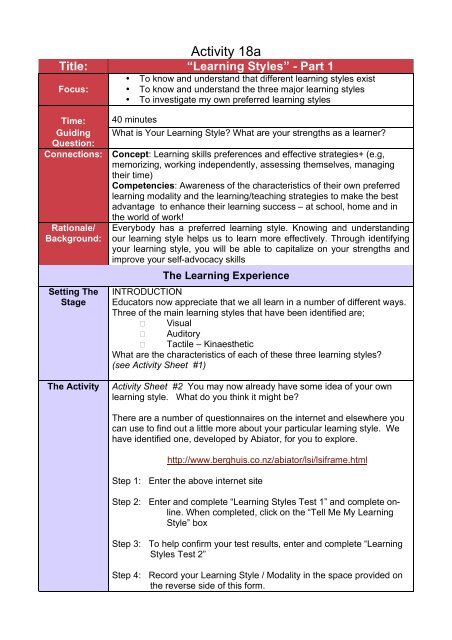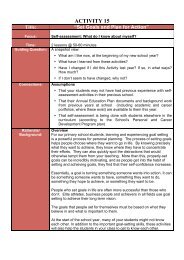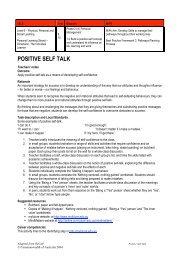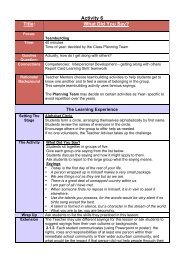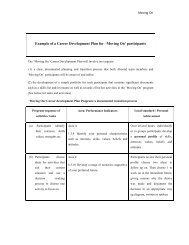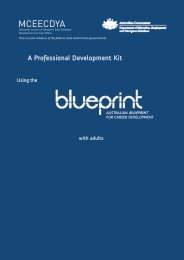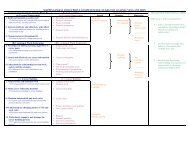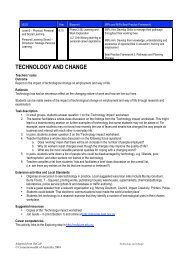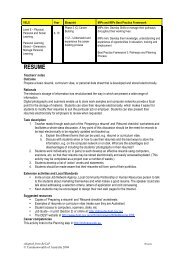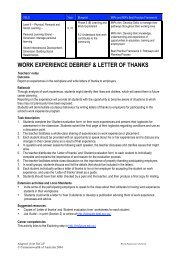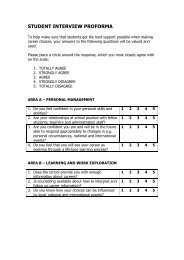Learning styles - Blueprint - Australian Blueprint for Career ...
Learning styles - Blueprint - Australian Blueprint for Career ...
Learning styles - Blueprint - Australian Blueprint for Career ...
Create successful ePaper yourself
Turn your PDF publications into a flip-book with our unique Google optimized e-Paper software.
Activity 18aTitle: “<strong>Learning</strong> Styles” - Part 1Focus:• To know and understand that different learning <strong>styles</strong> exist• To know and understand the three major learning <strong>styles</strong>• To investigate my own preferred learning <strong>styles</strong>Time:GuidingQuestion:Connections:Rationale/Background:Setting TheStageThe Activity40 minutesWhat is Your <strong>Learning</strong> Style? What are your strengths as a learner?Concept: <strong>Learning</strong> skills preferences and effective strategies+ (e.g,memorizing, working independently, assessing themselves, managingtheir time)Competencies: Awareness of the characteristics of their own preferredlearning modality and the learning/teaching strategies to make the bestadvantage to enhance their learning success – at school, home and inthe world of work!Everybody has a preferred learning style. Knowing and understandingour learning style helps us to learn more effectively. Through identifyingyour learning style, you will be able to capitalize on your strengths andimprove your self-advocacy skillsThe <strong>Learning</strong> ExperienceINTRODUCTIONEducators now appreciate that we all learn in a number of different ways.Three of the main learning <strong>styles</strong> that have been identified are; Visual Auditory Tactile – KinaestheticWhat are the characteristics of each of these three learning <strong>styles</strong>?(see Activity Sheet #1)Activity Sheet #2 You may now already have some idea of your ownlearning style. What do you think it might be?There are a number of questionnaires on the internet and elsewhere youcan use to find out a little more about your particular learning style. Wehave identified one, developed by Abiator, <strong>for</strong> you to explore.http://www.berghuis.co.nz/abiator/lsi/lsiframe.htmlStep 1: Enter the above internet siteStep 2: Enter and complete “<strong>Learning</strong> Styles Test 1” and complete online.When completed, click on the “Tell Me My <strong>Learning</strong>Style” boxStep 3: To help confirm your test results, enter and complete “<strong>Learning</strong>Styles Test 2”Step 4: Record your <strong>Learning</strong> Style / Modality in the space provided onthe reverse side of this <strong>for</strong>m.
Step 5. Finding out more about your preferred learning style:By clicking on the headings on the left hand side of theAbiator’s home page you can review, and record on this <strong>for</strong>m,in<strong>for</strong>mation regarding your “preferred <strong>Learning</strong> Style / Modality”.Wrap Up Activity Sheet #3Each student is asked to complete Activity Sheet #3, summarising anddescribing the research that they engaged in the exercise to assess their<strong>Learning</strong> Style and its implications.Extension<strong>Blueprint</strong> Indicators1.1.5Students write a one page autobiography which, in addition to thebiographical details of their lives, explains their interests, likes anddislikes, personal qualities, strengths and weaknesses. They reflect onthe impact of these personal qualities on their lives so far.1.1.7Students draw or paint a self-portrait which will become the centre of acollage illustrating their interests and self-image on one side, and theimpact on their lives and others perception of them on the other side.2.1.11Students can be encouraged to choose which Leadership Group theywant to belong to <strong>for</strong> the year, after consideration of their skills andinterests and the contribution they want to make to the school.Teacher Program Review – Reflective QuestionDo the students have awareness of their learning <strong>styles</strong>/modality and how they can applya variety of learning skills and strategies to a range of situations?1. Characteristics Of 3 <strong>Learning</strong> Styles / ModalitiesResources / 2. <strong>Learning</strong> Style AssessmentMaterials: 3. <strong>Learning</strong> Style Summary<strong>Blueprint</strong> <strong>Career</strong> Management Competencies & Indicators1.1.1 Understand the concept of personal characteristics such as interests, likes anddislikes, personal qualities, strengths and weaknesses.1.1.5 Identify positive characteristics (skills, interests, personal qualities and strengths) asseen by self and others.1.1.7 Assess your self-image and evaluate its impact on you and others2.1.1 Discover the unique character of individuals.2.1.11 Acknowledge and appreciate the unique character of self.4.1.2 Explore how skills, knowledge and attitudes acquired in one setting can contributein others (eg at school, at home, in the workplace and in the communityTeacher’sNotes:
CHARACTERISTICS OF 3 LEARNING STYLES / MODALITIESActivity Sheet #1<strong>Learning</strong> through seeing, reading and writing things down.Using and reacting to pictures, imagesVISUALAUDITORYLearn through seeing... .These learners need to see the teacher's body language andfacial expression to fully understand the content of a lesson.They tend to prefer sitting at the front of the classroom toavoid visual obstructions (e.g. people's heads). They maythink in pictures and learn best from visual displays including:diagrams, illustrated text books, overhead transparencies,videos, flipcharts and hand-outs. During a lecture orclassroom discussion, visual learners often prefer to takedetailed notes to absorb the in<strong>for</strong>mation<strong>Learning</strong> through listening and reacting to sound, voices,using and listening to music.Learn through listening...They learn best through verbal lectures, discussions, talkingthings through and listening to what others have to say.Auditory learners interpret the underlying meanings ofspeech through listening to tone of voice, pitch, speed andother nuances. Written in<strong>for</strong>mation may have little meaninguntil it is heard. These learners often benefit from readingtext aloud and using a tape recorder<strong>Learning</strong> by touching, feeling and movement, acting out, roleplaying, doing, making things.TACTILE – KINESTHETICLearn through , moving, doing and touching...Tactile/Kinesthetic persons learn best through a hands-onapproach, actively exploring the physical world around them.They may find it hard to sit still <strong>for</strong> long periods and maybecome distracted by their need <strong>for</strong> activity and exploration.
Activity 18bTitle: “<strong>Learning</strong> Styles” – Part 2Focus:• To identify my particular preferred learning style.• To identify the characteristics of my particular preferred learning style• To list three major strategies I can use to make the best advantage of mylearning style in order to enhance my learning success.Time:GuidingQuestion:Connections:Rationale/Background:Setting TheStageThe Activity40 minutesHow would identifying and analyzing their learning <strong>styles</strong> assist the students intheir personal <strong>Learning</strong> Pathway Plan and their Transition Pathways PlanImplications <strong>for</strong> Teaching and <strong>Learning</strong>Several major implications are apparent from these data:1. Most of your students learn differently than you do.2. Each of your students learns differently from your other students.3. No one teaching method will effectively reach all of your students.4. You cannot address all of your students' learning <strong>styles</strong> all of the time.The <strong>Learning</strong> ExperienceA knowledge of your own and others' preferred learning <strong>styles</strong> can be of greatbenefit to your study and learning at school, as well as any other aspect ofyour life that involves teaching and learning. Now that just about coverseverything!Activity 1: Students will explore further the concept of Preferred <strong>Learning</strong>Style / Modality, and where their own learning patterns fit thisconcept.A knowledge of your own and others' preferred learning <strong>styles</strong> can be of greatbenefit to your study at the College and university as well as any aspect ofyour life that involves teaching and learning. Now that just about coverseverything!Explore the following web-site assessments to expand your knowledge of yourpreferred learning style / modality.(i)Active and Reflective <strong>Learning</strong>:http://www.jcu.edu.au/office/tld/learningskills/learningst/active.html(ii)Analysis of Brain WorksThis is an interesting exercise called brain.exe . It will give you some morein<strong>for</strong>mation about your preferred learning style.http://www.jcu.edu.au/office/tld/learningskills/learningst/(iii) Sensing and Intuitive <strong>Learning</strong>Click on both of the figures in this following website to help you decide if you
have a preference <strong>for</strong> sensing or intuitive learninghttp://www.jcu.edu.au/office/tld/learningskills/learningst/sensing.html(iv) Visual and Verbal <strong>Learning</strong>Click on both of the figures in this following website to help you decide if youhave a preference <strong>for</strong> visual learning or verbal learninghttp://www.jcu.edu.au/office/tld/learningskills/learningst/visual.html(v) Sequential and Global <strong>Learning</strong>Click on both of the figures in this following website to help you decide if youhave a preference <strong>for</strong> sequential learning or global learning.Activity 2:Students will confirm and rein<strong>for</strong>ce their recognition of theirpreferred <strong>Learning</strong> Style / ModalityBy now you should be quite familiar with:Your preferred learning styleThree traits of your preferred learning styleThree strengths of your preferred learning styleThree appropriate strategies to enhance your learningStep 1:Within your sharing circle, discuss the following:How do you learn best according to the assessment?Do you agree with the assessment results? Why or why not?Tell about a time you learned something using your preferredlearning modality.Which one of the learning modalities seems least com<strong>for</strong>table toyou?Step 2:In pairs, with someone who has a different preferred learningstyle to yourself, share your answers to the questions outlined onActivity Sheet 4, about your preferred learning style, and recordyour findings as you go.Place your Activity Sheet 4 in your Journal.Step 3:Upon completion of your discussion, return to your sharing circleand discuss your Activity Sheet 3B responses within the group.In particular, share your opinion regarding:The value of knowing about learning <strong>styles</strong>The value of knowing the learning <strong>styles</strong> of others.
Wrap Up Activity 3: Students will address how to accommodate their <strong>styles</strong> todifferent environmentsStep 1: The Teacher shares what his/her preferred learning style /modality is. The Teacher calls out, "Fill in the blank: If you wantto help me learn be sure to______." Students respond.Step 2:Step 3:Step 4:Step 5:The Teacher calls out, "Fill in the blank: If you want to see mehave a hard time learning be sure to________." Studentsrespond.Students share how they would go about talking to someoneabout their preferred learning modality. The Teacher tells themthat it is certainly acceptable to share with their teachers, or withtheir employer in the future, how they learn best. It would help ifthe teacher could give an example of when s/he did this.Students are instructed to write an imaginary letter to theirteacher, or their employer, in which they introduce themselves,discuss their preferred learning style / modality and preferredlearning strategies, and discuss which style / modality andstrategies are most difficult <strong>for</strong> them.The Teacher reads the letters outside of class and writespositive feedback on each one thus acknowledging the studentspreferred learning style / modality and preferred learningstrategies.Extension 1.1.5 Students write a one page autobiography which, in addition to thebiographical details of their lives, explains their interests, likes and dislikes,personal qualities, strengths and weaknesses. They reflect on the impact ofthese personal qualities on their lives so far.Teacher Program Review – Reflective QuestionDo the students have awareness of their learning <strong>styles</strong>/modality and how they can apply avariety of learning skills and strategies to a range of situations?Resources / <strong>Learning</strong> Styles / Modality DiscussionMaterials:<strong>Blueprint</strong> <strong>Career</strong> Management Competencies & Indicators1.1.5 Identify your positive personal characteristics (skills, interests, personal qualities andstrengths) as seen by you and others.4.1.6 Identify your learning style, learning habits and study skills8.1.13 Engage in a responsible decision-making process.11.1.12 Examine your opinions and feelings about change, learning, following your heart,setting goals, focusing on the journey and having or developing a network of allies.Teacher’sNotes:
Activity Sheet 4<strong>Learning</strong> Styles / Modality Discussion1. What is your preferred learning style? __________________________________2. What is your partner’s preferred learning style? ___________________3. Tell your partner three traits of your preferred learning style._______________________________________________________________________________________________________________________________________________________________________________________________4. Tell your partner three strengths of your preferred learning style________________________________________________________________________________________________________________________________________________________________________________________________5. Tell your partner three appropriate strategies to enhance your learning________________________________________________________________________________________________________________________________________________________________________________________________6. Provide three (3) reasons why this in<strong>for</strong>mation is valuable to all learners?________________________________________________________________________________________________________________________________________________________________________________________________7. What is the value of knowing about learning <strong>styles</strong>?________________________________________________________________________________________________________________________________8. What is the value of knowing the learning <strong>styles</strong> of others?____________________________________________________________________________________________________________________________________________


